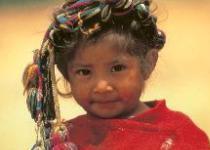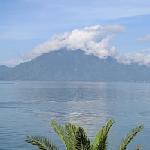
Guatemala Human Rights Commission/USA
.jpg)


.jpg)
Guatemala Blamed for Slow Aid to Mudslide Village
By Frank Jack Daniel
October 9, 2005PANABAJ, Guatemala (Reuters) - Aid trickled into a Guatemalan village devastated by a mudslide that killed some 1,400 people, and Maya Indian residents complained on Sunday the government was far too slow to react to the tragedy. Peasants from neighboring villages brought coats and clothing for the victims, rowing canoes across Lake Atitlan to Panabaj. The town was buried under a deadly slick of mud, rocks and trees that slid down a volcano after heavy rains from Hurricane Stan. Spanish firemen arrived to look for bodies under a quagmire that is up to 40 feet deep in places and Guatemalan soldiers brought water in a truck.
But government help was little and late, local officials said. They were angry that President Oscar Berger had not visited the village four days after one of Latin America's biggest tragedies of recent years struck. "I feel totally sad, morale is very low. We want to see the president, we want to see him here," said Diego Esquina, mayor of Santiago Atitlan municipality, which runs Panabaj. Stan's rains triggered the mudslide as Panabaj's residents slept early on Wednesday.
No senior government official went to the village and the mayor said racism against the Mayas might be to blame for their lack of interest. "It's like they are giving a message that it is because we are indigenous. That is the point. A lot of my people are saying it is because we are indigenous," Esquina said.
Santiago Atitlan was a hot spot during Guatemala's 36-year civil war, which ended in 1996. Years of abuses by soldiers helped leftist rebels recruit Indians in the town and tensions peaked in 1990 when drunken soldiers killed 13 locals.
A supply of beans, rice and pasta sent by the capital's city hall was handed out on Sunday but peasants said the federal government was negligent. “The government didn't send anything here. There is nothing," said Francisco Boron, 43, dressed in traditional calf-length white pants and carrying a machete. Rescuers with hand tools struggled to find bodies in the brown grunge covering Panabaj, and local officials said it would likely be left as a mass grave.
The fire department put the death toll at around 1,400 villagers and Esquina said between 1,000 and 1,500 had died. The storm killed some 300 people elsewhere in Guatemala and 103 others in the rest of Central America and southern Mexico. Guatemalan newspaper reports said several hundred people died at another landslide in the department of San Marcos near the Mexican border and some 2,000 were missing, but that could not be confirmed.
Defense Minister Carlos Aldana told Reuters the armed forces were trying to reach the stricken area. "San Marcos is the place where, from today, we are giving most importance because it has not been dealt with at all due to the weather conditions and the road access." he said. Around half a dozen light airplanes used by the army tried to fly to San Marcos on Sunday with food supplies but had to turn back 30 miles away at the town of Retalhuleu because of thick cloud in the mountains. Oliver Piedrasanta, 27, a fireman in that town, said whole neighborhoods in San Marcos had been buried by mud.
Home | Site Map | Contact Us
3321 12th Street NE, Washington, DC 20017
This site is maintained by the Guatemala Human Rights Commission/USA
as a means of informing the general public of the Commission's work
on behalf of the people of Guatemala
